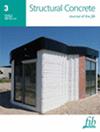聚乙烯和聚乙烯醇纤维/水泥基体之间的界面特性对砂浆和 ECC 特性的影响
IF 3.3
3区 工程技术
Q2 CONSTRUCTION & BUILDING TECHNOLOGY
引用次数: 0
摘要
探讨纤维/水泥基体之间的界面特性对纤维改性水泥基复合材料性能的影响。在水泥基材料中加入聚乙烯(PE)和聚乙烯醇(PVA)纤维,制备砂浆和工程水泥基复合材料(ECC)样品。测试了砂浆的机械性能、ECC 的拉伸能力、四点弯曲和孔隙率,以验证界面对样品性能的影响。此外,还利用水接触角分析了纤维的润湿性,并利用扫描电子显微镜(SEM)在微观尺度上观察了纤维/基质界面。分子动力学模拟从原子尺度计算了界面参数。结果表明,纤维增加了砂浆的韧性,提高了其抗折强度。通过扫描电镜发现,PVA 纤维能与水化基质形成紧密吸附。虽然聚乙烯/基质界面上有许多明显的裂缝和气孔,但粘结不良会破坏基质的结构,降低其抗压强度。通过分析 ECC 样品的性能可知,PVA-ECC 的应变率可达 5.73%,而 PE-ECC 为 4.20%。PE 纤维具有更高的机械强度,能承受更大的载荷,这有助于 PE-ECC 获得更大的弹性模量。核磁共振结果表明,PVA-ECC 的孔隙率低于 PE-ECC。PE-ECC 抗外界干扰能力较弱,PE/基质界面容易损坏。分子动力学模拟结果表明,PVA/CSH 之间的吸附能是 PE/CSH 的 6.17 倍。PVA/C-S-H 界面倾向于形成 CaO 和 H 键来加强键合,键合限制了原子的运动,使 PVA 链紧紧地吸附在 CSH 表面。而 PE 与 CSH 之间的吸附力较弱,PE 会从 CSH 表面脱离并形成聚集体。此外,PVA 和水分子形成稳定的氢键网络,促进水合作用在 PVA 纤维表面生长。然而,PE 纤维对水分子的吸附足够复杂,很难促进界面孔隙的形成。通过分析不同纤维与水泥基体之间的界面特性,可以为强化纤维水泥基体的界面特性,进而改善纤维水泥基复合材料的性能提供启示。本文章由计算机程序翻译,如有差异,请以英文原文为准。
Effect of interfacial properties between polyethylene and polyvinyl alcohol fiber/cement matrix on properties of mortar and ECC
To explore the influence of the interface properties between fiber/cement matrix on the performance of fiber‐modified cement‐based composite. Polyethylene (PE) and polyvinyl alcohol fiber (PVA) are brought in the cement‐based materials to prepare mortar and Engineered Cementitious Composite (ECC) samples. The mortar's mechanical, and ECC's tensile capacity, four‐point bending and porosity were tested to verify the interface's influence on samples' performance. Furthermore, the water contact angle was used to analyze the wettability of the fiber, and a scanning electron microscope (SEM) was used to observe the fiber/matrix interface on the microscopic scale. Molecular dynamics simulation was performed to calculate the interfacial paraments from an atomic scale. The results shows that fiber increases the toughness of the mortar and improved its flexural strength. Through SEM, it was found that PVA fiber can form tight adsorption with the hydration matrix. While there are many apparent cracks and pores at the PE/matrix interface, the poor bonding destroys the matrix's structure and reduces its compressive strength. By analyzing the performance of ECC samples, it was known that PVA‐ECC's strain rate can reach 5.73%, while PE‐ECC is 4.20%. PE fiber has higher mechanical strength and can bear more loads, it helps PE‐ECC to obtain a greater modulus of rapture. Nuclear magnetic resonance results showed that the porosity of PVA‐ECC is lower than PE‐ECC. The ability of PE‐ECC to resist external interference is weak, and the interface of PE/matrix is easily damaged. Molecule dynamics simulation results indicated the adsorption energy between PVA/CSH is 6.17 times that of PE/CSH. The PVA/C‐S‐H interface tends to form CaO and H‐bonds to strengthen the bonding, the bonding has limited the movement of atoms and making the PVA chains tightly adsorbed on the CSH surface. While the adsorption between PE and CSH is weak, the PE will detach from the CSH surface and form aggregates. Moreover, PVA and water molecules form a stable hydrogen bond network to promote the hydration production grows on the surface of PVA fiber. However, PE fiber is complex enough to adsorb water molecules and hardly encourage the development of pores at the interface. By analyzing the properties of the interface between different fibers and cement matrix can provide insights for strengthening the interface properties of fiber cement matrix, and then improve the properties of fiber cement‐based composites.
求助全文
通过发布文献求助,成功后即可免费获取论文全文。
去求助
来源期刊

Structural Concrete
CONSTRUCTION & BUILDING TECHNOLOGY-ENGINEERING, CIVIL
CiteScore
5.60
自引率
15.60%
发文量
284
审稿时长
3 months
期刊介绍:
Structural Concrete, the official journal of the fib, provides conceptual and procedural guidance in the field of concrete construction, and features peer-reviewed papers, keynote research and industry news covering all aspects of the design, construction, performance in service and demolition of concrete structures.
Main topics:
design, construction, performance in service, conservation (assessment, maintenance, strengthening) and demolition of concrete structures
research about the behaviour of concrete structures
development of design methods
fib Model Code
sustainability of concrete structures.
 求助内容:
求助内容: 应助结果提醒方式:
应助结果提醒方式:


